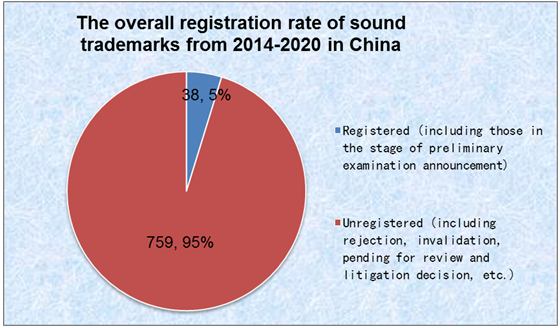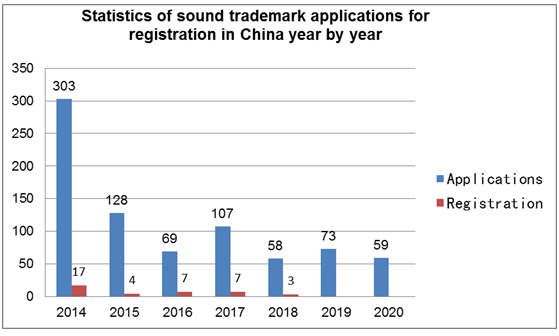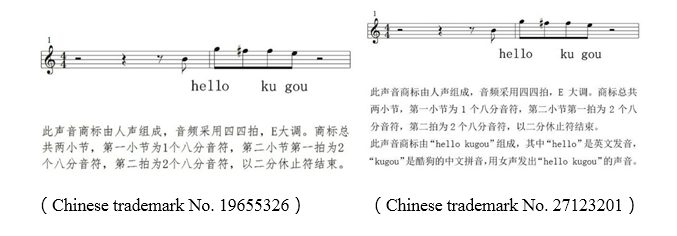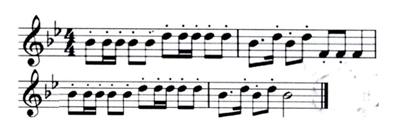The Status Quo of the Sound Trademarks in China
As a non-conventional trademark, sound trademarks have been eligible for registration in China since 2014. After several years’ practice, what is the current status of its applications for registration in China? This article intends to introduce and analyze the status quo and difficulties in registering sound trademarks in China, to provide more companies in need of applying for sound trademarks a more comprehensive and objective understanding of applications for registration concerning sound trademarks in China.
I. The initial introduction of sound trademark system in China
In China, the “visibility” required as the constitutive elements of a trademark has been deleted from the Article 8 of the
Trademark Law that came into effect on May 1, 2014,and a new type of non-conventional trademark- sound trademark has been added. At the same time, the
Regulations for the Implementation of the Trademark Law of the People's Republic of China was also revised in 2014, adding the formal examination standards for sound trademark registration applications in the fifth paragraph of Article 13. In addition, the part 6 of the Trademark Examination Standards of the first chapter of the
2014 Trademark Examination and Trial Standards also added formal and substantive examination standards for sound trademarks.
II. The success rate of sound trademark registration
In order to check the number of applications and registrations of sound trademarks in China in recent years, the author uses the CNIPA online database (
http://wcjs.sbj.cnipa.gov.cn/txnT01.do) to do the search and sort out relevant data.
According to the incomplete statistics publicly available on the CNIPA official database, in China, there were 797 applications for sound trademarks from May 1, 2014 to the end of 2020, of which only 38 have been registered (including 1 in the stage of preliminary approval and publication on Trademark Gazette), with the registration rate of only about 5%; and from the perspective of overall application and registration volume, we can draw a conclusion that although a wave of applications emerged at the beginning of the law amendment in 2014, with realizing the objective circumstances of the low registration rate, trademark applicants seems to become more and more cautious about the applications for sound trademark.

Unregistered (including rejected, pending in review of rejection and litigation, etc.)
 III. Difficulties in the registration of sound trademarks-distinctiveness determination
III. Difficulties in the registration of sound trademarks-distinctiveness determination
What is the reason for the low registration rate of sound trademarks in China? By analyzing the statistics and relevant application and registration examples, the author believes that this should be attributed to the over strict examination standards for the distinctiveness of sound trademarks in China's examination practice.
Firstly, whether a sound trademark itself is distinctive or not plays a significant role in determining whether it can be registered. China's
Trademark Examination and Trial Standards has the following provisions on the examination of distinctive features of sound trademarks.

Looking at the cases of unregistered sound trademarks, the trademark itself being indistinctive is undoubtedly the biggest obstacle in obtaining registration. As for under what circumstances should sound trademarks be deemed as lacking distinctiveness, the
Trademark Examination and Trial Standards merely gives a relatively broad description and lists several specific situations lacking of distinctive features, which are not clear enough. For example, how to define the “simple and ordinary” in “simple, ordinary tone or melody”, and how to determine the “ordinary intonation” and “common phrases” in “singing and reading advertising slogans or common phrases in the ordinary intonation” are not clearly defined.
For instance, Guangzhou Kugou Computer Technology Co., Ltd. tried to apply for its sound trademark “hello kugou” many times. Many of its applications failed to obtain registration, but some were successfully registered. Comparing the unregistered trademark No. 19655326 with the registered trademark No. 27123201 of the company, it can be found that the two trademarks are identical in composing elements and description of the sound trademarks are also quite similar. Why did the authority finally come to a different examination conclusion? It seems that there are also inconsistencies in the authority’s examination of distinctiveness.

Secondly, for the sound trademarks that have been registered in China, it is not difficult to see that they have been used in China for a long time and have a relatively high popularity among the relevant public, such as Nokia’s mobile phone ringtones, Intel’s computer startup melody, the opening melody of the 20th Century Fox movie, the opening song of China Radio International (China’s first registered sound trademark), Unicharm’s “sofy” (The first sound trademark registered by a foreign trademark applicant in China).

(Trademark No. 14515370- Nokia’s mobile phone ringtones)

(Trademark No. 14503615- the opening song of China Radio International)
The
Trademark Examination and Trial Standards provides that “
the Trademark Office may issue an Office Action requesting the applicant to submit the use evidence and explain how the trademark has acquired distinctive features through use.” It is difficult to judge how much use evidence the applicant need to provide to prove that the trademark has acquired distinctive features through use. According to the public information on CNIPA online database, many applicants of sound trademarks that failed to obtain trademark rights received office action after the application was submitted, but most of them failed to persuade the examiner in the response and ended up with the rejection.
For this situation, some have pointed out that requesting the applicants of sound trademarks to provide use evidence in the registration application stage and treating them differently from conventional trademarks such as word trademarks greatly increases the threshold for registration of sound trademarks and almost deprives the possibility of registration from most sound trademarks.
The same situation applies to foreign applicants. Even though a sound trademark is well-known and has been approved for registration in the applicant’s own country, it is still necessary to consider its popularity among the relevant public in China, which may directly lead to the unavailability of the registration of the sound trademarks in China for many foreign applicants. Taking Japan's Daiko Pharmaceutical Co., Ltd. as an example, its sound trademark composed of a horn melody (see the picture below) has obtained trademark rights in Japan, but it failed to register in China.

(Chinese trademark No.
18485240)

(Japanese trademark No. 5985746)
The applications for registration of sound trademarks have existed in China for 6 years, but the registration rate has remained very low. In the author’s view, the authority should give more detailed and valuable suggestions for applications for the registration of sound trademarks.
It is known that the China Trademark Office is making new revisions to the
Trademark Examination and Trial Standards, wherein the amendment of examination standards for sound trademarks is included. Will this revision appropriately relax the examination standards for the distinctiveness of sound trademarks? Will a more detailed explanation be given to the examination standard? Will the requirement to provide use evidence in the substantive examination stage be revised? Let us find the answer together in the new
Trademark Examination and Trial Standards coming soon in the future!








